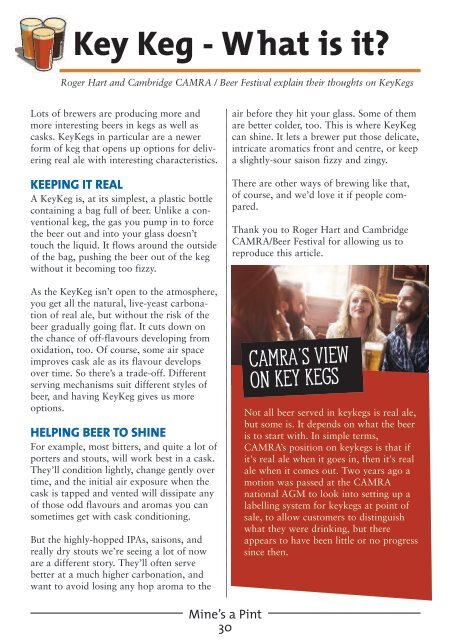You also want an ePaper? Increase the reach of your titles
YUMPU automatically turns print PDFs into web optimized ePapers that Google loves.
Key Keg - W hat is it?<br />
Roger Hart and Cambridge CAMRA / Beer Festival explain their thoughts on KeyKegs<br />
Lots of brewers are producing more and<br />
more interesting beers in kegs as well as<br />
casks. KeyKegs in particular are a newer<br />
form of keg that opens up options for delivering<br />
real ale with interesting characteristics.<br />
KEEPING IT REAL<br />
A KeyKeg is, at its simplest, a plastic bottle<br />
containing a bag full of beer. Unlike a conventional<br />
keg, the gas you pump in to force<br />
the beer out and into your glass doesn’t<br />
touch the liquid. It flows around the outside<br />
of the bag, pushing the beer out of the keg<br />
without it becoming too fizzy.<br />
As the KeyKeg isn’t open to the atmosphere,<br />
you get all the natural, live-yeast carbonation<br />
of real ale, but without the risk of the<br />
beer gradually going flat. It cuts down on<br />
the chance of off-flavours developing from<br />
oxidation, too. Of course, some air space<br />
improves cask ale as its flavour develops<br />
over time. So there’s a trade-off. Different<br />
serving mechanisms suit different styles of<br />
beer, and having KeyKeg gives us more<br />
options.<br />
HELPING BEER TO SHINE<br />
For example, most bitters, and quite a lot of<br />
porters and stouts, will work best in a cask.<br />
They’ll condition lightly, change gently over<br />
time, and the initial air exposure when the<br />
cask is tapped and vented will dissipate any<br />
of those odd flavours and aromas you can<br />
sometimes get with cask conditioning.<br />
But the highly-hopped IPAs, saisons, and<br />
really dry stouts we’re seeing a lot of now<br />
are a different story. They’ll often serve<br />
better at a much higher carbonation, and<br />
want to avoid losing any hop aroma to the<br />
air before they hit your glass. Some of them<br />
are better colder, too. This is where KeyKeg<br />
can shine. It lets a brewer put those delicate,<br />
intricate aromatics front and centre, or keep<br />
a slightly-sour saison fizzy and zingy.<br />
There are other ways of brewing like that,<br />
of course, and we’d love it if people compared.<br />
Thank you to Roger Hart and Cambridge<br />
CAMRA/Beer Festival for allowing us to<br />
reproduce this article.<br />
CAMRA’S VIEW<br />
ON KEY KEGS<br />
Not all beer served in keykegs is real ale,<br />
but some is. It depends on what the beer<br />
is to start with. In simple terms,<br />
CAMRA’s position on keykegs is that if<br />
it's real ale when it goes in, then it's real<br />
ale when it comes out. Two years ago a<br />
motion was passed at the CAMRA<br />
national AGM to look into setting up a<br />
labelling system for keykegs at point of<br />
sale, to allow customers to distinguish<br />
what they were drinking, but there<br />
appears to have been little or no progress<br />
since then.<br />
Mine’s a <strong>Pint</strong><br />
30

















